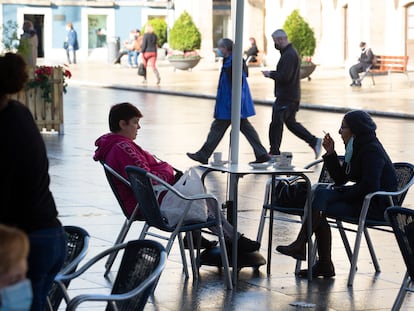Spain’s coronavirus incidence rate exceeds ‘extreme risk’ level
According to the latest Health Ministry report, the 14-day cumulative number of cases per 100,000 inhabitants now stands at 253.7 – the highest figure since November 30

Spain’s coronavirus incidence rate is once again at high-risk levels. According to the Spanish Health Ministry’s latest report, released Wednesday evening, the 14-day cumulative number of cases per 100,000 inhabitants in Spain now stands at 253.7 – above the 250-threshold which is used by the ministry, in addition to other factors – to classify a situation of “extreme risk.” It is also the highest figure Spain has recorded since November 30. According to the report, 12,386 new coronavirus cases were recorded and 178 deaths added to the official toll.
Health Minister Salvador Illa called on the public to be “extremely prudent” over the Christmas holidays
Although Spain’s incidence rate has been rising since December 9, the spike has yet to increase the strain on hospitals. A total of 11,328 Covid-19 patients are currently in hospital, which translates to an occupancy rate of 9.2%. Of this figure, 1,932 are in intensive care units (ICUs), occupying 20.2% of all ICU beds. The Health Ministry, however, believes pressure on hospitals is likely to soon increase in response to the rise in cases.
Speaking at a government press conference on Wednesday, Health Minister Salvador Illa expressed concern about the “upward evolution” of infections. “We are very worried, and we are heading into the holidays, when there is an increase of mobility and social contact,” he said. The minister added that most authorities in regions, where the incidence rate was rising, had taken “stricter measures ahead of Christmas.”
According to Wednesday’s report, the Balearic Islands continue to have the highest incidence rate in Spain, with the 14-day cumulative number per 100,000 inhabitants at 455 – nearly double the national average. The archipelago is followed by Madrid (361), Valencia (346), Extremadura (337), Castilla y León (305) and Catalonia (301). The incidence rate is stable in most of the regions with the lowest number of new cases. This is the case for Asturias (147), Cantabria (162), Castilla y León (169) and Galicia (179). But in others, for example, Andalusia (147), the Canary Islands (139) and Murcia (160), there has been a slight uptick.
The Health Ministry report also classified the risk level of each of Spain’s 17 regions. This is defined based on the incidence rate, as well as other factors, such as hospital occupancy and the positivity rate i.e. the percentage of tests that come back positive out of the total. According to the ministry’s criteria, five regions are at extreme risk (Catalonia, Valencia, Madrid, Castilla y León and La Rioja), seven are at high risk (Asturias, Cantabria, Basque Country, Castilla-La Mancha, Aragón, Andalusia and the Balearic Islands), three are at medium risk (Navarre, Extremadura and Murcia) and two are at low risk (Galicia and the Canary Islands). Speaking on Wednesday, Illa called on the public to be “extremely prudent” over the Christmas holidays.
Coronavirus vaccination drive
Health Minister Illa also presented the details of Spain’s coronavirus vaccinations drive on Wednesday. According to Illa, Spain will receive 4.5 million doses of the vaccine developed by Pfizer and BioNTech over the next 12 weeks. A total of 350,000 doses will be delivered each week and divided between Spain’s regions. The first vaccination will take place on December 27 in Guadalajara, which has been chosen because Pfizer has a warehouse in the city.
English version by Melissa Kitson.
Tu suscripción se está usando en otro dispositivo
¿Quieres añadir otro usuario a tu suscripción?
Si continúas leyendo en este dispositivo, no se podrá leer en el otro.
FlechaTu suscripción se está usando en otro dispositivo y solo puedes acceder a EL PAÍS desde un dispositivo a la vez.
Si quieres compartir tu cuenta, cambia tu suscripción a la modalidad Premium, así podrás añadir otro usuario. Cada uno accederá con su propia cuenta de email, lo que os permitirá personalizar vuestra experiencia en EL PAÍS.
¿Tienes una suscripción de empresa? Accede aquí para contratar más cuentas.
En el caso de no saber quién está usando tu cuenta, te recomendamos cambiar tu contraseña aquí.
Si decides continuar compartiendo tu cuenta, este mensaje se mostrará en tu dispositivo y en el de la otra persona que está usando tu cuenta de forma indefinida, afectando a tu experiencia de lectura. Puedes consultar aquí los términos y condiciones de la suscripción digital.
More information
Últimas noticias
Reinhard Genzel, Nobel laureate in physics: ‘One-minute videos will never give you the truth’
Pinochet’s victims grapple with José Antonio Kast’s rise in Chile
From digital curfews to blocking apps: How technology experts protect their children online
Why the price of coffee has skyrocketed: from Brazilian plantations to specialty coffee houses
Most viewed
- Pablo Escobar’s hippos: A serious environmental problem, 40 years on
- Why we lost the habit of sleeping in two segments and how that changed our sense of time
- Trump’s obsession with putting his name on everything is unprecedented in the United States
- Charles Dubouloz, mountaineering star, retires at 36 with a farewell tour inspired by Walter Bonatti
- The Florida Keys tourist paradise is besieged by immigration agents: ‘We’ve never seen anything like this’











































